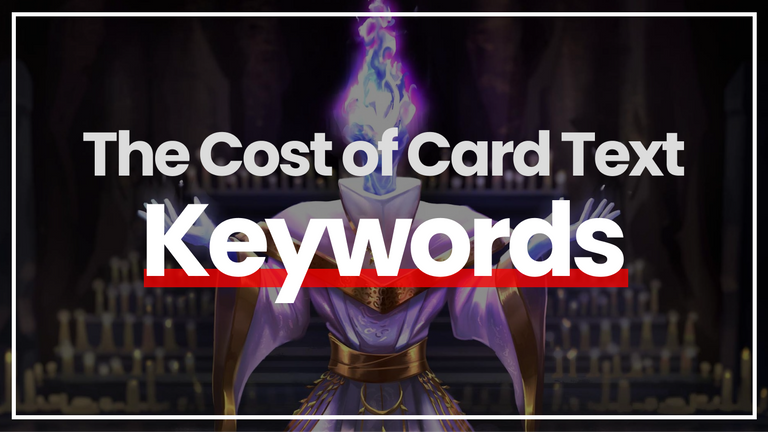
As a follow-up to my previous post regarding the base statlines a vanilla creature has, let's discuss how much stats card text theoretically costs. Card text refers to anything in the body section of a card, including keywords like Blitz and Confused, as well as any effects like healing. Naturally, cards with beneficial card text like Blitz or "Heal a friendly creature for 2" will have worse stats as compared to the vanilla creature, while cards with detrimental effects like "Afterlife: Your opponent summons a random creature from their void" will have better stats than the vanilla creature. The reason is simple - you would simply pick the vanilla creature otherwise. So what do these keywords actually cost?
Let's dive right in!

Reference: The Vanilla Creature Statline Table
In this post, all comparisons are done against the stats for a vanilla creature. Although not a perfect way of comparison, for consistency and convenience I will usually use the total stat points (Attack + Health points) when comparing 2 cards. For example, a 2/6 (8 stat points) is said to have 2 extra stat points over a 3/3 (6 stat points). To see which creatures have the vanilla stats, do refer to my previous post!
| Mana Cost | Stat Points |
|---|---|
| 1 | 4.5 |
| 2 | 6 |
| 3 | 7 |
| 4 | 9 |
| 5 | 11 |
| 6 | 13 |
| 7 | 20 |

Keywords
Let's start off with the biggest category, keywords. Keywords are common effects that are seen in many cards, so to reduce the number of words used in the card text, the game designers opted to shorten them into one or two words. Since some keywords don't have enough data points, some of these estimations may not be entirely accurate.
Blitz
Creatures with Blitz can attack enemy creates, but not gods, the turn they are summoned.
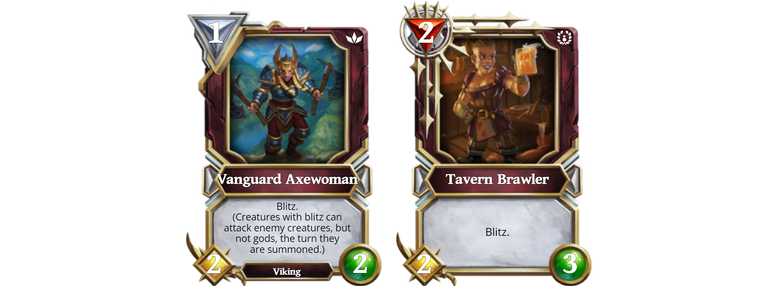
Interestingly enough, there are only 2 cards that only have Blitz with no other card text. For the Vanguard Axewoman, it costs 0.5 stat points, while for the Tavern Brawler, it costs 1 stat point. I think it's safe to say Blitz should cost between 0.5 - 1 stat point.
Confused
When a confused creature attacks, there is a 50% chance that it attacks a valid random character instead.
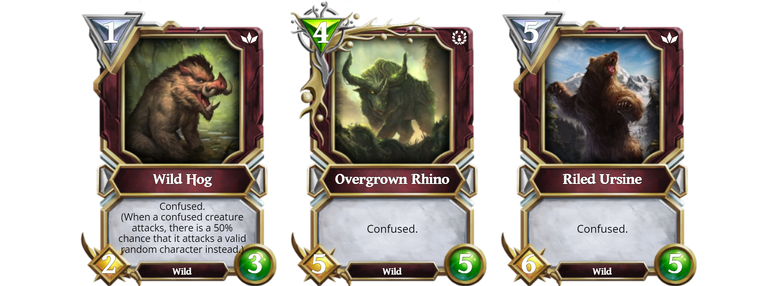
The three cards that have Confused as its sole card text are the Wild Hog, the Overgrown Rhino, and the Riled Ursine. Doing comparisons with the vanilla creature statline, we can see that Confused adds anywhere from 0 - 1 stats to the creature as a trade for random targeting. However, I think the Riled Ursine is strictly outclassed by the stronger Brazen Moose, which costs the same but has 6/6 in stats and Blessed. It's probably more accurate to say that a creature having Confused should have an extra 0.5 - 1 stat points.
Frontline
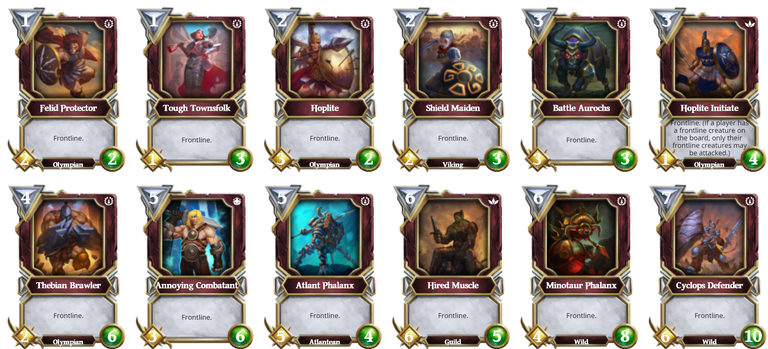
There are plenty of units with only Frontline as their sole card text. At this point, it gets a bit tricky. For creatures with 1 - 4 mana cost, Frontline costs about only 1 stat point, but that cost increases to about 2 - 4 stat points for units in the 5 - 7 mana cost range, with Minotaur Phalanx as an exception. It makes sense - Frontline gains value as the creature becomes bigger and is able to block more enemy creatures.
Deadly
Any amount of deadly damage will destroy a creature.
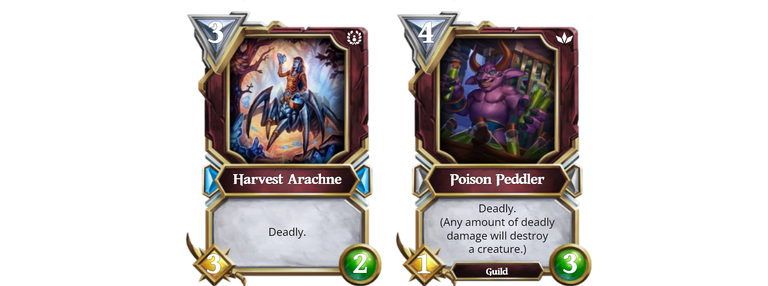
Deadly is tough to evaluate since the attack stat on the creature doesn't matter unless dealing with enemy creatures with armor. Fascinatingly, the 3-cost Harvest Arachne has more overall stats than the 4-cost Poison Peddler, but is less useful in general due to its lower health. Instead of comparing these cards using their total stat points, if we use their health points as a basis for comparison, Deadly seems to cost about 2 health points on average.
Flank
This creature can attack any character, ignoring frontline and backline, if any other character has attacked this turn.

Flank is a keyword that is seemingly thrown in for free for certain cards, costing 0 stat points for all these cards except for the Glider Assailant which has 1 stat less than its vanilla counterpart. Fair, since Flank's effect is usually not of much use in most circumstances.
Hidden
Hidden creatures cannot be attacked or targeted by enemy spells or abilities. They become unhidden when they attack.

Hidden comes in at a cost of 0.5 - 1 stat points for all mana costs here. A fair cost for a fair ability.
Protected
Protection stops the next source of damage this creature would take.
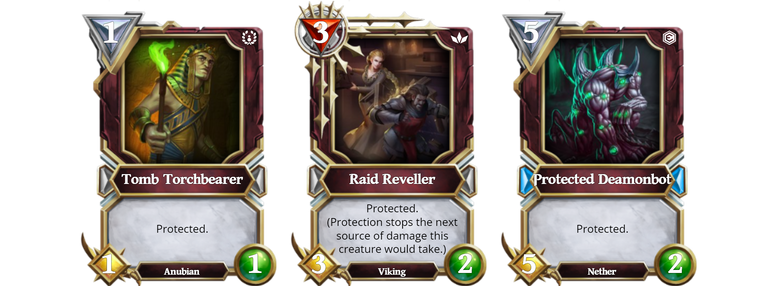
Protected, being a fairly strong keyword, comes in at a cost of 2 stat points for the lower mana cost cards, and 4 stat points for the Protected Deamonbot. Acceptable, since dealing with Protected often costs the opponent 2 mana to deal with it if they have a 1-damage god power or even more if they have to make inefficient trades against the Protected creature.
Blessed
When summoned, delve 3 blessed effects and play one.

Blessed, being a keyword that was only introduced in the Divine Order set, only has the Planetar Acolyte as a card that solely has the Blessed keyword. Since we can't draw much data just from one card, I looked at a few other Blessed cards and found out that Blessed tend to cost anywhere from 0 - 1 stat points, sometimes being thrown as a "freebie" with other effects.
Twin Strike
Can perform two attacks. You can't use both of those attacks on a god.
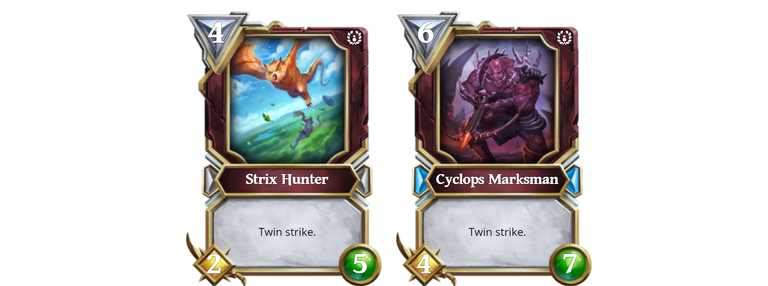
Twin Strike comes in at a cost of 2 stat points. Since Twin Strike gains value the more health the creature has, you might come across low-health Twin Strike creatures that seem to have this keyword for a lower stat cost, like the Nokkvi Pillager.

Ward
Blocks one instance of destroy, transform, sleep or non-attack damage from any opponent's source.

Only the Dryder Sailweaver has Ward as its sole keyword. Looking at a few other cards, it seems that Ward tends to cost about 0.5 stat points or bundled as a "freebie" with other effects.

Why are Some Cards Considered Overpowered (OP) or Underpowered (UP)?
With a rough estimation of the cost of each keyword, we can now see how these plays into cards with multiple keywords or effects.
Cards that people consider are OP often include a bunch of keywords that have synergy and/or cost less than their individual costs, while cards that are UP punch below their weight and have insufficient stats for the effects that they have.
Let's take a look at some of these cards.

Archangel Bruiser is commonly considered to be really strong in most War decks and bordering on OP. With 8 total stat points, you can say that it trades one stat point for the Blitz keyword. This means that its conditional Frenzy is given as a freebie, which turns out to be really strong on a creature with Blitz. It's no wonder that this card is getting a -1 health nerf soon.

Orcish Elite trades 2 attack points for both the Blitz and the Twin Strike keyword, making it a really good deal, since they would have cost 3 points individually.

Let's take a look at the almost-never played Wizened Warlock. At a 2/2 body for 3 mana, it trades off 3 stat points for Ward and the ability to deal 1 damage to a random enemy each turn. Due to how fragile it is, the ability to deal 1 damage to a random enemy is unlikely to be worth the 2 stat points, rendering it to be UP by today's standards.

The Runaway Trebuchet trades off a staggering 6 stat points for Blitz and a random 2 damage ping. Is the 2 damage ping worth that many stat points?

Card Evaluation is Tough
Even with all this analysis, it's hard to evaluate cards because they often cannot be evaluated correctly in a vacuum. In combo decks, the strength of individual cards matter much less compared to how it contributes to the overall win condition - you might be putting way under-statted cantrips (Draw 1 when played) just to draw your combo.
Some keywords and effects are just much stronger together. For example, the Blitz and Overkill keywords make a great combination. Blitz and Twin Strike are also great together. When these two keywords are given together on a creature, it may be fair to lower its stats even further to compensate for how strong the combination of keywords is.
Card strength is also dependent on the other cards available within that Faction. Its possible to have a strictly worse version of a card in another faction due to the synergies that it brings to the table.

For example, I recently saw in a Reddit discussion that compared these two cards, Just a Nibble and Revivification. Just a Nibble was going to get nerfed to heal only 5 health, and it didn't seem fair that Revivification wasn't receiving the same nerf. After all, Revivification cost one mana less, had no detrimental effect of having to deal 1 damage to your own creature, and even had a possible positive effect of adding a random Nature card to your hand. The reason why Just a Nibble was nerfed is simply that it was way too strong when combined with the other Death cards, like Siren of the Grave. Revivification had no synergies with any other Nature cards.
On top of all these, Legendary cards are also balanced differently. Since you can only include 1x of a Legendary in your deck, they are much less likely to be drawn on any given turn as compared to something that you've included 2x of. Due to this limitation, they are given better stats and effects as compared to regular cards. This is also the reason why people complain about decks that are chock full of legendaries - they simply are stronger.

Oddi is simply a better Raid Reveller - no questions asked.

I hope this breakdown of keyword cost did help open your eyes a little to how cards are evaluated. GU has many card effects which help to make the game more dynamic and fun, but it's also good to be aware of what you're trading off for those effects and keywords.

Post Header image source: Gods Unchained Media Kit
If you chanced upon this article and are interested in starting Gods Unchained, you can use my referral code to sign up to play here. It's free to play and free to earn!
Some of the card images in this post are generated by GUListCreator, a tool I created for fast card list lookup and creation to write posts like this on Hive. Do check it out if you like to create content for Gods Unchained!
Nice bro, newbies will get ahead on understanding with this one! going to make a stream command to share this one!
Thank you! That would be awesome! 😄
Excellent breakdown of the stats! I've actually been meaning to do something similar for spells, as the meta reports have made it quite clear some players are using certain spells more often than their actual effects suggest they should be ;P
Please do! It's way harder to evalute spells and I'd be really interested in what the results show. There are definitely some hidden gems hiding within the depths of the collections.
Great read, thanks for the write up! This reminded me of the type of thinking that one must partake in for the Arena mode in other TCGs (and hopefully this one soon), trying to figure out the 'value' of each keywords in your minions, and comparing them to other options.
Yup, like you, I'm also waiting for the Sealed mode to make its re-debut in GU. (hope you've been saving up Stars for it too!) In a way, you're right that this kind of analysis is more relevant to Arena deck building since you often can't form synergies and need to evaluate cards on their own. Hopefully this helped shed some light!
You think it will cost star bois? I haven't been saving at all, been buying useful cards from the shop...
It seems to be what the team used for Sealed PTR early last year, so it's likely that it will be the currency needed to enter (5k stars per pop). Not sure when it will ever be released though, this blog post was a year ago.
https://blog.godsunchained.com/2021/01/29/sealed-deck-approaches/
Thanks for the link, super cool. Maybe i'll keep a couple potential runs saved up now:)
Great information, and helped me understand some things about Gods Unchained, I might really start playing it very soon when my schedule permits XD
But I really learned some things from your post, especially how the cards work, and given me the idea about different stats.
!1UP
Glad it helped! Do check out the other articles in the community, there are many guides and helpful tips that are posted regularly here. Hope you do start GU, it's a game that stands well on its own even without the crypto aspects 😄
Great article!
I love the clear explanation and providing the points breakdown for keywords; that really helps the community start to understand and evaluate what make a card good/playable.
Thank you! Glad it helped 😄
Man, these breakdowns are always a pleasure to read through. It's clear you really went deep and did some analysis! Especially useful for new players indeed 👍
Thank you! Glad you enjoyed it.
A great read, full of useful info as usual! Nicely done.
Thank you!
Good and organize information!
This post remind me the rule in r/customhearthstone, they mark most keyword and make sure people won`t create some OP cards haha.
Thank you! Haha yeah, I think custom cards that seem possible to be in-game are the best since there's actually a chance that game developers actually take inspiration from them.
The rewards earned on this comment will go directly to the person sharing the post on Twitter as long as they are registered with @poshtoken. Sign up at https://hiveposh.com.
You have received a 1UP from @ivarbjorn!
@oneup-curator, @neoxag-curator, @pal-curator, @pob-curator, @vyb-curatorAnd look, they brought !PIZZA 🍕 The following @oneup-cartel family members upvoted your post:
Delegate your tribe tokens to our Cartel curation accounts and earn daily rewards. Join the family on Discord.
Congratulations @kephler!
You raised your level and are now a Minnow!
Check out the last post from @hivebuzz:
In this case, I think I'm the confused creature.
I saw "vanilla", I thought the post was about food, then I saw "creature" and I thought maybe animals?
Is this like a block chain game?
Haha sorry for confusing you, this is indeed a post about a blockchain TCG, Gods Unchained. In TCG vernacular "vanilla" is often used to describe a card without any card text/effects, and creature is just how the game terms the cards on the board.
Oh Okay. I get.
Thanks for the explanation.